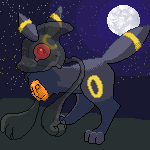Free CSS, Userscripts, etc
Forum Index > Other > Other Art >
Hey Dr Who! I was wondering, would it ever be possible to make a script that counts the ammount of albinos you've hatched in a chain? I was thinking about it the other night, and I feel like it's for sure possible -- I just dont know enough about this kind of code to make it happen :0
★ Zachary ★ They/He ★ 22 ★
Quiet nature collector.Hi Colorful^^ I don't think that's easily possible. A userscript can only tackle things on the frontend of PFQ. What a script could do is:
* check the Shiny Hunting page to determine what <species> you are hunting
* watch you hatch your party, if you hatch an albino <species> matching your chained species, increment a number by 1
* persist that number somewhere (your about me in a cute badge?)
* if you hatch an egg that breaks your chain, reset the counter to 0
These steps could be implemented in the backend by a PFQ admin. Even if chaining albinos is not a thing in PFQ's domain logic it sounds to me like it wouldn't be too complex to add?. I guess a new table could be added with 3 columns: the user, the albino count and the melan count. Then some steps could be added to the hatch function similar to the steps described above.
🪃 *the boomerang flies back to you*
... But if that is not a thing, I think that you could actually solve this problem? :'D Basically a script would just maintain a counter and add +1 to it. Since you do stunning templates, maybe you could code up an awesome display for your hunt stats, and we update the A/M part manually? A pretty counter would be fun to keep up to date imo c;
Avatar by Kaelwolfur.
Sent from my PokéNav
Hi!! The reason I came to you first and not to the suggestions form, is because
1.) Niet has mentioned that you cant track albinos (which I interpreted as "I dont want too set that up," since from your explanation and my personal thought process, I can think of ways to do it.)
2.) Suggestions take absolutely forever
3.) I'm not 100% convinced that we're even getting the approved suggestions implimented anymore, and that they'll only be on PFNew :S
Also, I do have several areas where I list my chain stats!! I just wondered if there would be a way to be sure that the numbers are correct, or to even have it upgrade on it's own.
Do you think it'd be worth setting up a suggestion for at all?
Yeah I see what you mean with the suggestions atm. But an accurate albino counter is really a problem for the backend and not the frontend :c If you feel this should be reconsidered as a suggestion, why not?~ The suggestions forum is still open after all.
Hey there! Not sure if I am posting this in the right spot.
But a few years back I had made a suggestion in the forums about implementing a pop-up window in the market like the one for the pokedex. So you don't have to keep re-scrolling everytime you want to check out summon prices and such.
And I was wondering if it's at all possible via user scripts? I have no idea what I am doing in user scripts but I am greatly enjoying the QoL user script hub and was wondring if something of the sort can be added in?
Thank you for your time!!


Snowpix - Made by Chronos

 Thanks to Zanitha for making my snorpix(fusion sprite) for me as a gift and to Zorualord14for my Goldpix trophy
Thanks to Zanitha for making my snorpix(fusion sprite) for me as a gift and to Zorualord14for my Goldpix trophyHi Sparkys, thanks for the suggestion but I gotta admit I haven't been very motivated to write scripts here lately. Anyway I did take a look and here's what I have so far - it's not at all robust, but if you want to do something with it or send it to someone who will, please be my guest.
Basically it stops the default behaviour when you click a button and launches the window instead.
Sorry for all the 'a' 'b' variables, this is mostly copied & edited from the PFQ debugger. The code in the debugger/on pfq is minified (shortened as much as possible) to make things faster, but as a result it becomes illegible.
$("#marketinventory").off();
function m(a, removeSpinner) {
ajax("marketboard/load", { item: a })
.success(function (b) {
new Dialog('Item details', b.html, [{ text: "close" }]);
removeSpinner()
})
.failure(function () {
alert('Sorry, userscript error')
removeSpinner()
});
}
$("#marketinventory").on("click", (e) => {
console.log(e)
var a = $(e.target),
b = a.data("selectitem");
a = a.closest(".tooltip_content").prev("span").html();
if (!a) return false
const [spinner, removeSpinner] = createSpinner()
$(e.target).prepend(spinner)
m(b, removeSpinner);
return false
});
function createSpinner() {
const spinner = $.loadingSpinner()
const removeSpinner = () => spinner.remove();
return [spinner,removeSpinner]
}
Thank you very much for looking into it! I'll try fiddling with it :D
[I posted this in the wrong thread, sorry]
Type Race: 0
Profile pic by xaandiir from their artshop (click their name for the shop!)


 Here thar be Dragons
Here thar be Dragons




 Here thar be Dragons
Here thar be Dragons


A good friend asked if I could post this code from several years ago, please find it below.
Building on the code above, I've added some style for colours, padding and alignment. Lastly, I'd like to mention that not every browser supports every feature of CSS. For instance, our template uses CSS grid which may not be available in old browsers. One option for our template to fail gracefully would be to only replace titles with arrows when the browser supports flex. Unfortunately, this requires a feature query which the PFQ parser does not seem to allow. However, we can fall back on flex to ensure the 'current' tab is adequately large when the browser does not support grid.
Creating an arrow interface
In this post I'm going to give a rundown on how to create a tabbed interface that you can navigate with arrows. If you like, you can open a template editor and build it as we go.
Basic setup
We're going to start off with a tabbed_interface and some code that is not yet relevant to the arrow interface.[sc=tabbed_interface horizontal]
[ul]
[li]One[/li]
[li]Two[/li]
[li]Three[/li]
[li]Four[/li]
[/ul]
[sc=tab]Lorem ipsum dolor sit amet, consectetur adipiscing elit. Etiam placerat tempor felis vitae consequat. Donec at sapien sapien. Nulla lectus ipsum, ultricies id maximus eget, luctus id tellus.[/sc]
[sc=tab]Donec pellentesque ligula sit amet purus efficitur suscipit. Nunc nisi arcu, vulputate vel tortor et, volutpat malesuada lorem.[/sc]
[sc=tab]Etiam fermentum erat ac ultrices elementum. Ut at nibh justo. Vestibulum odio orci, sodales eu sapien et, consequat viverra risus.[/sc]
[sc=tab]Duis posuere sem enim, sit amet iaculis purus accumsan finibus. Proin ante arcu, ullamcorper a neque in, tempor ultricies metus. Donec at ipsum interdum, elementum mauris quis, efficitur dolor.[/sc]
[/sc]
[style]
/* ignore whitespace between elements */
.tabbed_interface {
white-space: nowrap;
&>ul>li,
&>div {
white-space: pre-line;
}
}
/* reset styles */
.tabbed_interface,
.tabbed_interface > ul,
.tabbed_interface > ul > li,
.tabbed_interface > div {
padding: 0;
margin: 0;
background: none;
box-shadow: none;
border: none;
border-radius: 0;
}
[/style]
We set white-space: nowrap on .tabbed_interface to collapse all newlines. This allows for nicer formatting of your post, you can separate [sc=tab]The first tab[/sc]
[sc=tab]The second tab[/sc] into several lines without actually pushing the second tab a line down. However, this also squishes all text into a single line. To prevent this, we set white-space: pre-line on ul>li and div which is where our text lives. The result is that line breaks are ignored between elements and preserved within content sections.
Additionally, we also strip all elements of the .tabbed_interface off their padding, margin, borders, shadows and colours so we can start with a blank slate. If you preview this now, you'll end up with a barren tabbed_interface. Our next task is to add the arrows.Setting up the grid
For the next task, we're going to turn the ul into a css grid by adding the following style./* set up the grid */
.tabbed_interface > ul {
display: grid;
grid-template-columns: 1fr 66% 1fr;
}
ul is now a grid made up of three columns. First, the centre column is given 66% of the available width. The left and right column are given an equal fr value, which means that all remaining width is shared equally between them. To illustrate, you could have written this as 17% 66% 17%. The benefit of CSS grid in this situation is that we can place items into grid cells explicitly. Our goal is to place the li corresponding to the 'previous' tab in the left cell, the li of the 'current' tab in the centre cell and the li of the 'next' tab in the right cell. How do we identify the 'previous', 'current' and 'next' li?Placing items
/* previous tab */
.tabbed_interface > ul > li {
grid-row: 1;
grid-column: 1;
z-index: 1;
}
There is no distinguishing class for the 'previous' tab. What we will do is the style above which applies to all li, and then have the 'current' and 'next' tab override that style as needed. The style places all li at column row 1 column 1 in the grid. Assigning a z-index allows multiple li to stack in the same grid cell./* current tab */
.tabbed_interface > ul > li.tab-active {
grid-column: 2;
}
/* next tab */
.tabbed_interface > ul > li.tab-active + li {
grid-column: 3;
}
Next, we identify the 'current' tab through its .tab-active class and place it in the centre column.
Lastly, we identify the 'next' tab through a sibling combinator as li.tab-active + li. That means "the tab immediately following .tab-active". We place it in the third and rightmost column./* tabs beyond the next tab */
.tabbed_interface > ul > li.tab-active + li ~ li {
display: none;
}
Any tabs beyond the 'next' tab can be identified through yet another sibling combinator. li.tab-active + li ~ li means "all li following the li immediately following li.tab-active". In our layout, we only care about the 'previous', 'current' and 'next' tab so we choose not to display those beyond. If we don't do this, they will stack on the left and cover the 'previous' arrow. To recap, we now have a column on the left where all tabs before the 'current' tab stack. The 'previous' tab is on top of that stack and therefore clickable. The 'current' tab is in the centre and the 'next' tab is on the right. Our next modification is going to be replacing the titles of the 'previous' and 'next' tabs with a left and right arrow respectively.Arrows
To insert the arrows, let's revise the styles for the 'previous', 'current' and 'next' tab./* previous tab */
.tabbed_interface > ul > li {
grid-row: 1;
grid-column: 1;
z-index: 1;
font-size: 0;
&:before {
font-size: 1rem;
content: "←"
}
}
Note that we've added a :before element with the content value "←". If the tab previously read 'About', it will now read '←About'. Next, we set the font-size of li to 0 which removes all text. The :before element overrides this with a font-size of 1rem. Continuing the example above, 'About' lives in li while '←' lives in li:before. We've essentially replaced the content of the 'previous' tab with an arrow./* current tab */
.tabbed_interface > ul > li.tab-active {
grid-column: 2;
font-size: 1rem;
&:before {
display: none;
}
}
Remember that we have to override the style for the 'current' and 'next' tab as needed. In the current tab, we want the title to display, but the arrow to not display./* next tab */
.tabbed_interface > ul > li.tab-active + li {
grid-column: 3;
&:before {
content: "→"
}
}
The adjustment for the 'next' tab is that we want the content in :before to be a right arrow and not a left arrow.
Now we have a fully functional navigation interface. The 'previous' tab is on the left with its title replaced with an arrow, the 'current' tab is in the centre and the 'next' tab is on the right with its title replaced with an arrow. All that's left to do is to style our interface.The result
- One
- Two
- Three
- Four
Lorem ipsum dolor sit amet, consectetur adipiscing elit. Etiam placerat tempor felis vitae consequat. Donec at sapien sapien. Nulla lectus ipsum, ultricies id maximus eget, luctus id tellus.
Donec pellentesque ligula sit amet purus efficitur suscipit. Nunc nisi arcu, vulputate vel tortor et, volutpat malesuada lorem.
Etiam fermentum erat ac ultrices elementum. Ut at nibh justo. Vestibulum odio orci, sodales eu sapien et, consequat viverra risus.
Duis posuere sem enim, sit amet iaculis purus accumsan finibus. Proin ante arcu, ullamcorper a neque in, tempor ultricies metus. Donec at ipsum interdum, elementum mauris quis, efficitur dolor.
Something I was able to do with the hatching userscript! In the case of not being able to find an egg of the mon that you are wanting to get the animation of, you can find an egg of the same tying, edit the egg url under elements before entering the script, and then run the script and it will visually look like the same egg
Hatched Shinies
glitter glitter, shine so brightHatched Albinos
pastel power!Hatched Melans
heart attack in a purple sparkleHatched Eggs
so many eggs.....0 pts
.
Cannot post: Please log in to post










 121
121


